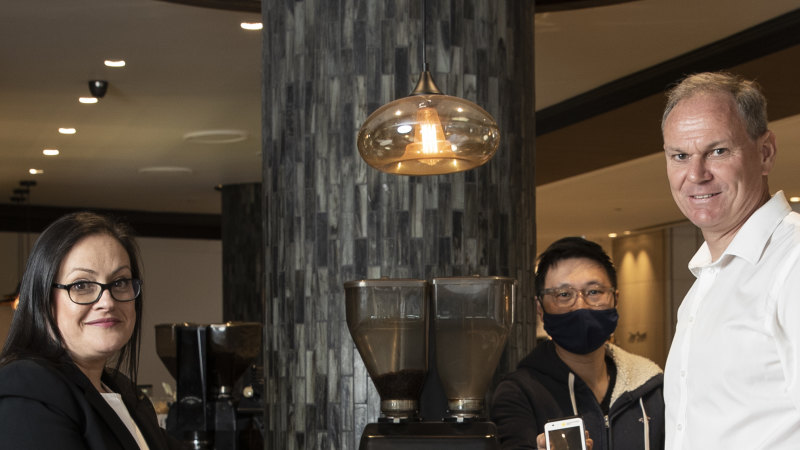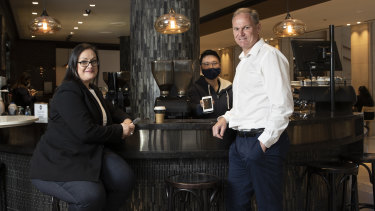The Commonwealth Bank has sharpened its attack on National Australia Bank’s title as the country’s leading business bank, launching a suite of new merchant products and declaring its services now lead the pack.
CBA’s general manager of merchant solutions Karen Last declared CBA was now Australia’s leading business bank, despite NAB still retaining the largest market share, according to recent data released by the prudential regulator.
“We believe we are the leading business bank across the spectrum of products,” she said. “We are laser focused on meeting customer needs. We believe new customers will be attracted to that … We certainly think we are taking a leading position.”
CBA general manager of merchant solutions Karen Last with group executive for business banking Mike Vacy-Lyle and Charles Wang, business owner at cafe Nevaggio.Credit:Louie Douvis
Services for small business owners is emerging as a key battleground as the banking industry competes for returns amid historically low interest rates. NAB has long branded itself as Australia’s biggest and leading business bank, but CBA has made inroads over the past 18 months beginning with a recruitment drive of 120 business bankers.
Chief executive Matt Comyn has expressed his desire to grow market share in the lucrative sector and in June senior executive Mike Vacy-Lyle described CBA as the “sleeping beast” in business banking, pledging to disrupt the sector through product innovation.
CBA on Wednesday launched a new fleet of merchant terminals that enable small business owners to plug into two network providers and Wi-Fi to avoid restrictions on accepting payments during service outages. Next week, CBA will roll out a flat fee of 1.1 per cent for all instore transactions, slightly cheaper that NAB’s 1.15 per cent starting rate.
Ms Last said the revamped merchant terminals were an important tool for the bank to attract new small business customers, and the new features were implemented in direct response to customer feedback.
“If you sit in one of our call centres and listen to calls for any duration of time, connectivity is always a key issue. You can never afford to have merchant terminals down,” Ms Last said.
Ms Last said the merchant terminals would pave the way for its new and existing small business customers to take up additional products within the bank, like loans.
“[It’s] setting up your [transaction] account first, and then merchant facilities coming off it are at the core of any relationship we have and a key enabler actually for some of our lending propositions as well,” she said.
The latest APRA data shows NAB retains its number one position, with 21.9 per cent of the business banking market. Ms Last said she could not discuss modelling around what impact the terminals will have on CBA’s market share but added she was “very comfortable” it would claw new customers away from competitors.
NAB’s business banking boss Andrew Irvine in March brushed off concerns over competition in March, after announcing 134 new small business bankers had been hired. “More competition breeds better outcomes for customers. I welcome competition,” Mr Irvine said.
NAB’s merchant services executive Mark Raymer said in a statement he was “focused on what matters to our customers”.
“And they’re telling us they want us to support them to ensure they can bounce back quickly, so that’s what we are concentrating on with more bankers in our network, simpler and faster lending to small businesses and a simplified and competitive merchant offer,” he said.
The Business Briefing newsletter delivers major stories, exclusive coverage and expert opinion. Sign up to get it every weekday morning.
Most Viewed in Business
From our partners
Source: Read Full Article

